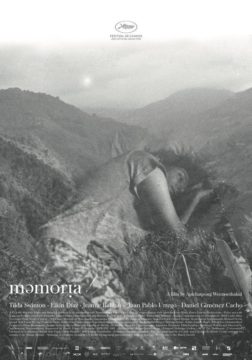by Danielle Spencer
 Last night I (Danielle Spencer) went to the New York Film Festival screening of Memoria (dir. Apichatpong Weerasethakul) in Alice Tully hall at Lincoln Center. I last joined a large gathering 19 months ago, in March of 2020.
Last night I (Danielle Spencer) went to the New York Film Festival screening of Memoria (dir. Apichatpong Weerasethakul) in Alice Tully hall at Lincoln Center. I last joined a large gathering 19 months ago, in March of 2020.
The film opens a soundscape, memoryscape, landscape—and a bodyscape, all of us in the vast hall sloping gently down towards the screen like a nighttime jungle floor. The opening scene is still, close and quiet, and then there is a very loud sound, which startles me. It also startles Jessica (Tilda Swinton) who awakens in surprise. I am anxious that there will be more surprising loud sounds. Then Jessica rises and sits in a room of the house. She looks at what in my memory is a small bright aquarium in front of the windows, warmly lit with orange fish. The space and sound around the aquarium are dark and oceanic.
In the opening passages of Austerlitz (W.G. Sebald) the narrator travels by train to Antwerp. He finds his way to the zoo and sits beside an aviary full of brightly feathered finches and siskins fluttering about, and then visits the Nocturama, peering at the creatures in their enclosures, leading their sombrous lives behind the glass by the light of a pale moon. He returns to the waiting room of the Centraal Station, remarking that it ought to have cages for lions and leopards let into its marble niches, and aquaria for sharks, octopuses, and crocodiles, just as some zoos, conversely, have little railway trains in which you can, so to speak, travel to the farthest corners of the earth. As the sun sets and the light dims in the station waiting room, he sees the waiting travelers in miniature, as the dwarf creatures in the Nocturama.
When I was ten my father and I spent the spring in Budapest, where he proved theorems at the Institute of Mathematics and I was enrolled in the Kodály music school. Our small apartment building was near the top of a hill on the hilly western Buda side of the city, home to several mathematicians and their families. Some nights we went up the street to eat schnitzel at the restaurant on the corner. Read more »
